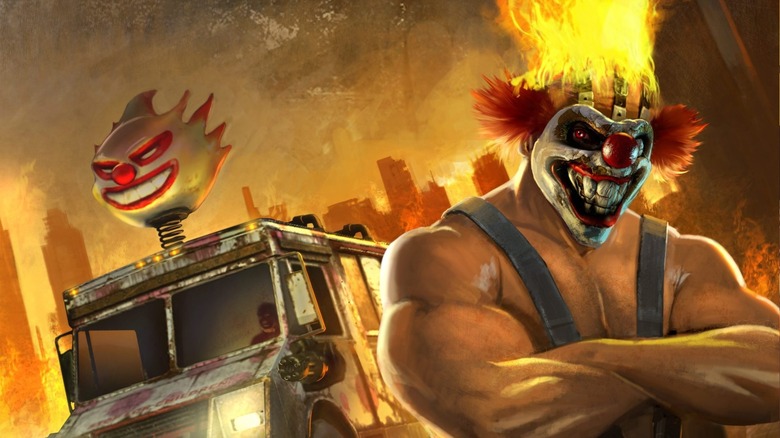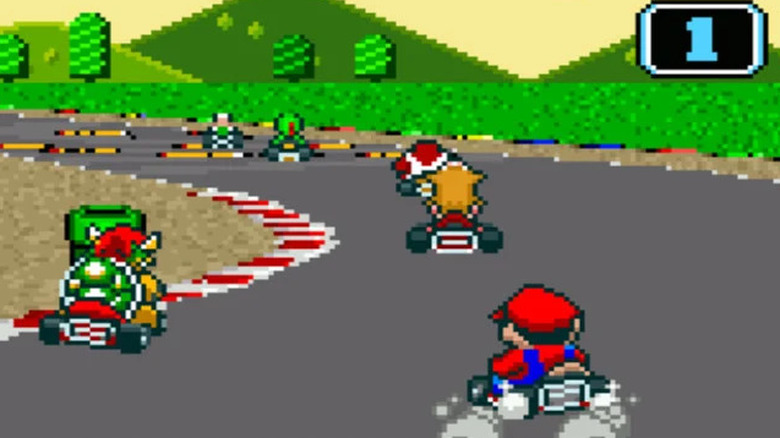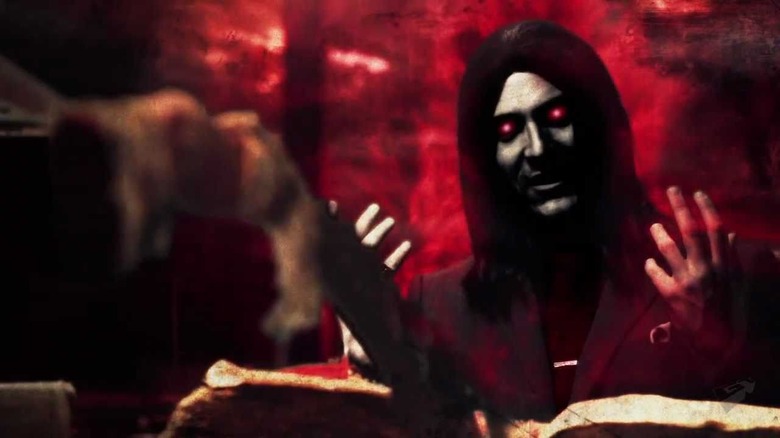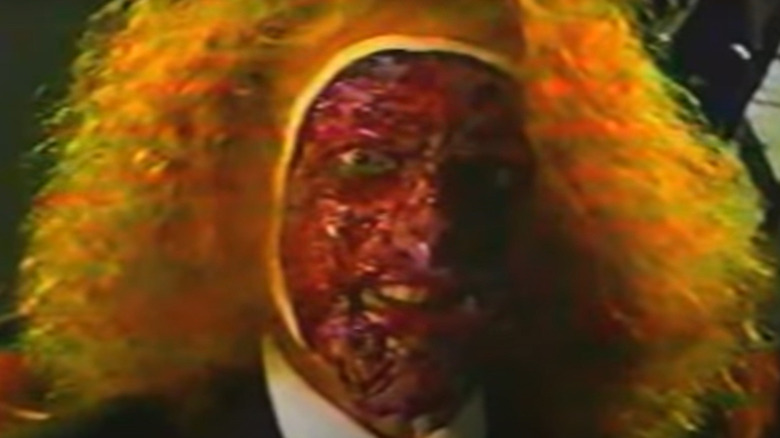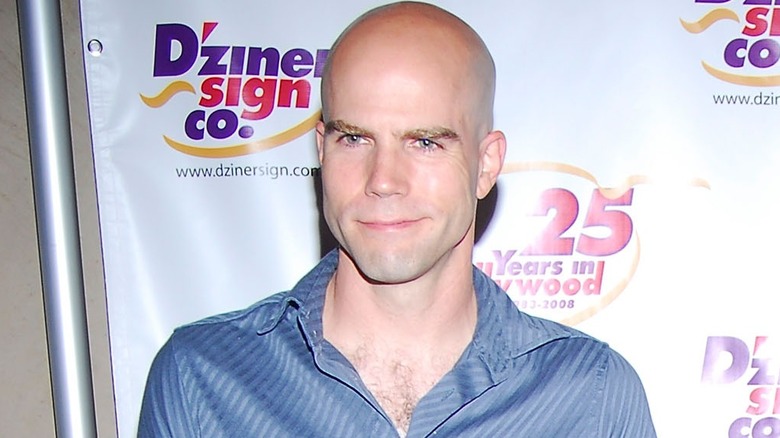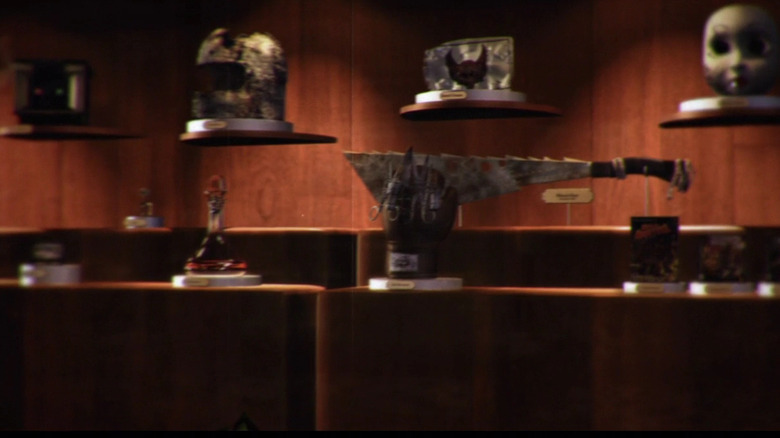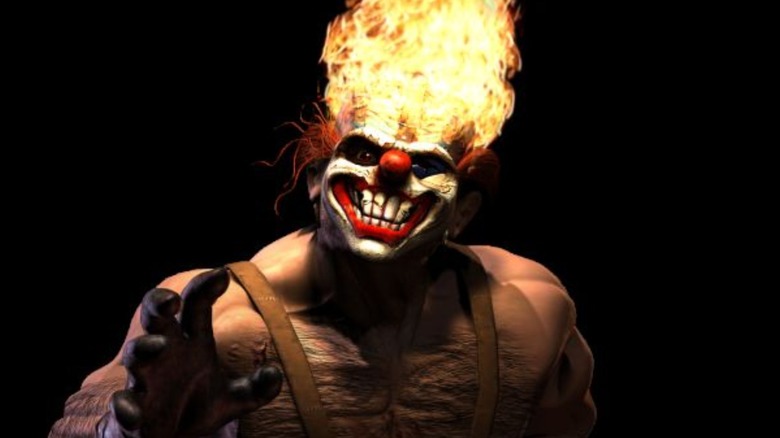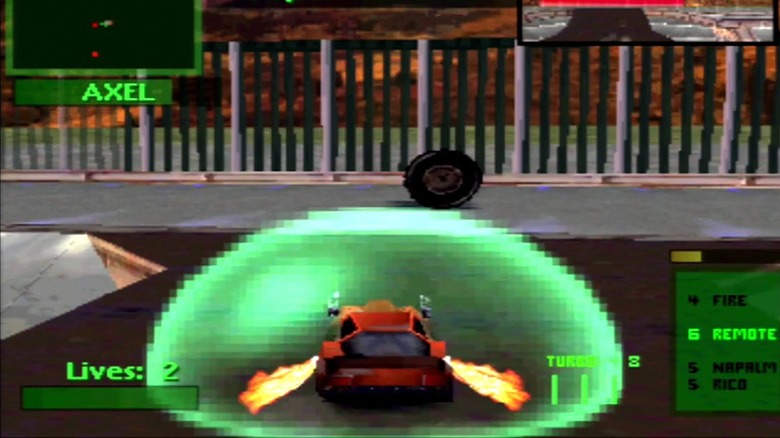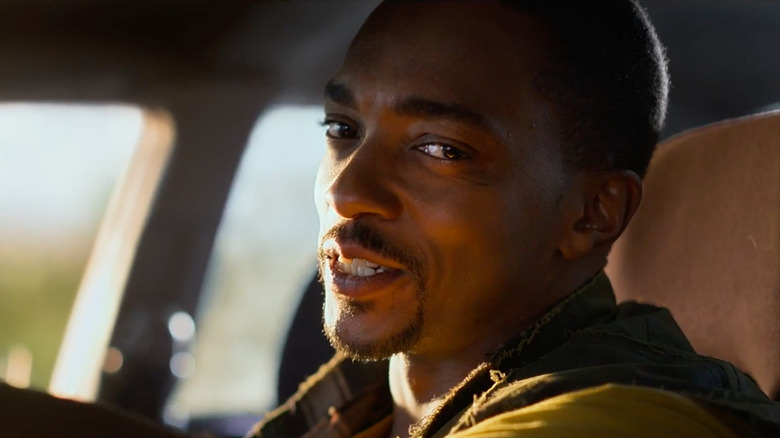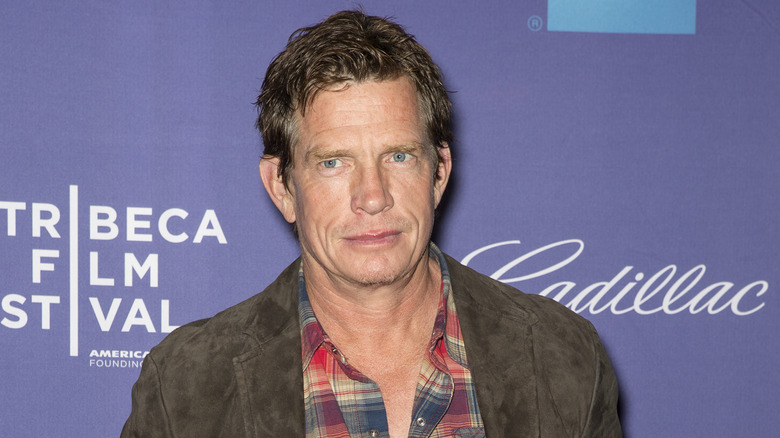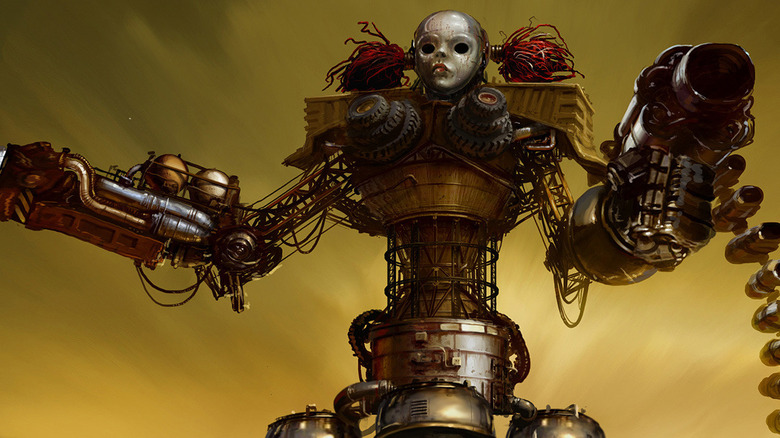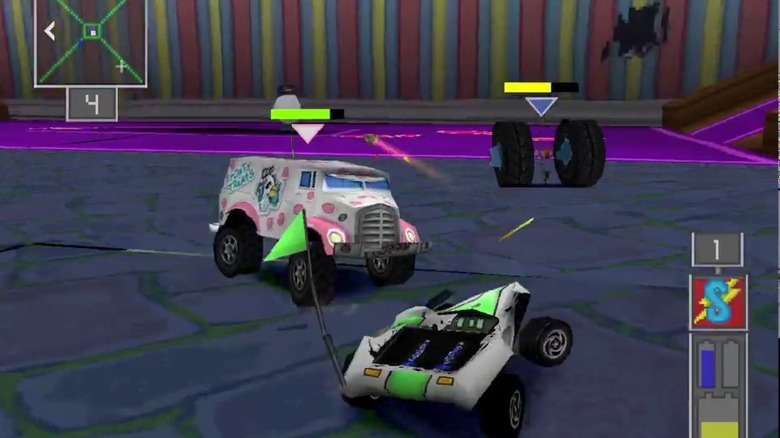The Untold Truth Of Peacock's Twisted Metal
"Twisted Metal" is a popular video game franchise and the originator of the "vehicular combat" genre. In vehicular combat games, players control over-the-top vehicles (typically cars) and utilize explosive weaponry to destroy other drivers in deadly demolition derbies. "Twisted Metal" paved the road for other popular titles like "Vigilante 8" and "Star Wars: Demolition."
In 2023, "Twisted Metal" will be adapted into a big-budget series for Peacock starring Anthony Mackie, Tahj Vaughans, and Stephanie Beatriz with guest appearances by Neve Campbell and Thomas Haden Church. Joe Seanoa, aka pro wrestler Samoa Joe, plays the iconic evil clown Sweet Tooth with the assistance of executive producer Will Arnett, who voices the character. Writers Rhett Reese and Paul Wernick ("Deadpool") came up with the streaming series' concept, while Michael Jonathan Smith ("Cobra Kai") acts as the showrunner (via Deadline).
However, unlike the games' story about a deadly tournament, the upcoming "Twisted Metal" show will somehow instead follow, in Peacock's words, "a motor-mouthed outsider (Mackie) offered a chance at a better life, but only if he can successfully deliver a mysterious package across a post-apocalyptic wasteland. ... He'll face savage marauders driving vehicles of destruction ... including a deranged clown who drives an all too familiar ice cream truck."
It remains to be seen how well the "Twisted Metal" streaming series will stack up against the classic video games, but we're here to tell you about the franchise — from its origins to its unmade games, and even its multiple and intersecting timelines. Buckle up.
Game mechanics originally inspired by Mario Kart
Despite "Twisted Metal" being widely considered the first full-fledged vehicular combat game, there were some pseudo precursors, such as the controversial 1976 arcade game "Death Race 2000" based on the movie of the same name, and 1980's "Battlezone."
However, according to an oral history compiled by Mel Magazine, lead director Dave Jaffe — who would later create the equally prominent "God of War" series — stated in an interview that the main influence was surprisingly much more kid friendly. "To figure 'Twisted Metal' out, we played a ton of 'Mario Kart' in battle mode," he said.
Now, while "Mario Kart" is ostensibly a racing game where players choose which cute Nintendo character they want to see drive a go-kart, the game also has a popular (and arguably more fun) battle mode. In that mode, players must navigate their chosen Nintendo character's kart around an enclosed level, collecting power-ups to attack their opponents until there's only one kart left standing.
This connection between the two games makes perfect sense considering how the mechanics of "Twisted Metal" are nearly identical to "Mario Kart" — both games entail driving in enclosed arenas, collecting unique and varied power-ups, and limited lives. Of course, the "Twisted Metal" game developers made sure that, unlike "Mario Kart," each vehicle had its own special moves; the police cruiser Outlaw uses a giant taser attack, which is more similar to games like "Street Fighter" and "Mortal Kombat," rather than other mascot kart racing games in the same vein as "Mario Kart."
The Twisted Metal games are supernatural
An issue with many video game adaptations is that they aren't accurate to the source material. Most infamously, the "Super Mario Bros." dark cyberpunk thriller from the '90s has hardly any resemblance to its eponymous game franchise whatsoever. Luckily, the recent successes of "The Last of Us" and the animated "Super Mario Bros." movie have shown Hollywood the value of fidelity.
So, it's strange how the concept cooked up by screenwriters Rhett Reese and Paul Wernick is so different from the game's core concept. This is because none of the entries in the "Twisted Metal" series are set in a post-apocalyptic world, and they all feature the mysterious and magically powerful Calypso — the host of the dangerous underground car combat tournament known as "Twisted Metal." The drivers in this tournament drive souped-up and weaponized vehicles and fight each other to the death under the pretext that Calypso will grant a wish to the survivor. These wishes range from the usual — fame, revenge, etc. — though sometimes a driver wants Calypso to do things like turn a paper bag into a friend. These wishes also usually get — for lack of a better term – twisted in a "Monkey's Paw" sort of way.
Calypso's role as the host of the tournament and the darkly humorous ways the wishes of the "Twisted Metal" winners backfire on them have always been a staple of the franchise, yet Calypso has yet to be mentioned in any of the show's press materials. Hopefully, Peacock finds a way to bring the supernatural element, and Calypso, into the series somehow.
Certain Twisted Metal games contain live-action cutscenes
The first "Twisted Metal" game was one of the first titles released exclusively for the Sony PlayStation. Besides taking advantage of the PlayStation's fully three-dimensional and detailed (for the time) polygonal models, there was also the fact that the CD tech the PS1 utilized allowed for FMVs, or "full-motion videos," which the console-based tech of the Nintendo 64 didn't really have the storage capacity for (via Digital Spy).
Because of this, the "Twisted Metal" developers decided to actually film live-action endings for each of the drivers after they won the game, similar to the individual character endings from fighting games like "Mortal Kombat" and "Street Fighter II."
In each of the endings, the winner of "Twisted Metal" drives into a dingy underground garage and meets Calypso (played by actor Charles Lance), who has an extremely burnt face, cartoonishly curly hair, a surprisingly slick business suit, and a throne made out of discarded car parts. Calypso isn't alone, either, as he's flanked on either side by scantily clad women in bikinis and shirtless bodybuilder types carrying assault rifles as security. The drivers then exit their vehicles and ask Calypso to grant their wish ... though, of course, the wish doesn't usually turn out the way the driver intends.
Unfortunately, due to the low production quality, these FMV cutscenes were taken out of the final game and replaced with a still photo of Calypso's burnt face and scrolling text. However, the concept of FMV cutscenes were eventually used in 2012's "Twisted Metal" reboot for the PS3.
Brian Taylor was going to helm a canceled Twisted Metal movie
Filmmakers Brian Taylor and Mark Neveldine are known for their wild and borderline dangerous directing style, often doing their own shooting while wearing roller skates or skateboarding. The two collaborated as co-directors on multiple films, including the Jason Statham-led "Crank" films, 2009's "Gamer" starring Gerard Butler, and 2011's "Ghost Rider: Spirit of Vengeance."
Eventually Taylor and Neveldine went on to pursue their own projects. One such project that Taylor gravitated towards was a proposed "Twisted Metal" feature film adaptation timed around the release of the PlayStation 3 reboot. Not much is known about this version of the "Twisted Metal" story, other than Taylor wanted to cast Nicolas Cage, who he had worked with previously on the aforementioned "Ghost Rider: Spirit of Vengeance," as the iconic evil clown serial killer, Sweet Tooth.
Unfortunately, in an interview with Collider, Taylor explained that the film failed to ignite due to budgetary concerns, stating, "It was a movie that felt like it needed to be $50 million, but they didn't feel that the fanbase really merited that kind of movie; it really wanted to be more of a $15 million movie, but the nature of it with the set pieces would've just made it too big."
It's a shame, too, as his frenetic filmmaking style would've been a potentially good match with the high-octane source material; he and Neveldine's previous film, "Gamer," shows they have a love and understanding of the medium.
The games' convoluted lore includes multiple timelines
"Twisted Metal" has been aptly described as "'Mortal Kombat' with cars." Not only do both game franchises contain edgy '90s-exxxtreme aesthetics and over-the-top characters, but both franchises also have convoluted lore that spans multiple universes and timelines.
See, the original two games in the "Twisted Metal" series were developed by SingleTrac studios in 1995 and 1996, but due to financial issues, the studio eventually lost the rights to make "Twisted Metal" games. Luckily, many developers from SingleTrac would create Incognito Entertainment, and — among other titles — develop "Twisted Metal: Head-On" in 2005 for the PSP, which acted as a de-facto "Twisted Metal III" in what we're dubbing the "SingleTrac-verse."
After SingleTrac lost the rights to make more "Twisted Metal" games, in 1998 and '99 a "Twisted Metal III" and "Twisted Metal 4" were developed by 989 Studios. Unfortunately, due to critical backlash against the changes to the game's lore and physics, many fans don't consider these "true" sequels, so are often deemed non-canon.
Then, in 2001, a dark and gritty reboot titled "Twisted Metal: Black" was released, where the drivers are all inmates at the fictional Blackfield Asylum. Incognito Entertainment developed this reboot before working on the aforementioned "Twisted Metal: Head-On" afterward. However, due to its dramatically different aesthetics and tone from the other games, the game is obviously set in its own "Black-verse."
Finally, in 2012, there was a complete PlayStation 3 reboot — simply titled "Twisted Metal" — with no connection to any of the previous games in the series.
Twisted Metal: Black takes place inside Sweet Tooth's head
Despite keeping a lot of the fundamentals of the franchise, 2001's "Twisted Metal: Black" for the PlayStation 2 is a big departure from the original "Twisted Metal" games. For instance, the game discards many of the supernatural elements, except for Calypso granting wishes and Sweet Tooth's head, which remains constantly on fire. The character Mr. Grimm from the original PS1 games goes from being the literal Grim Reaper to a scarred Vietnam vet wearing his friend's skull as a helmet in "Twisted Metal: Black." The visuals in "Black" were also much darker than previous games, having an almost surreal Tim Burton-style feel. Finally, it's the first in the series to be rated "M for Mature."
Furthermore, if you unlock the mid-game boss Minion, his ending reveals that "Black" all takes place inside Sweet Tooth's warped mind. While in the previous SingleTrac-verse entries, Minion is a hulking, red-skinned demon, in "Black," he's just a human wearing a bloody bull's head and driving a giant armored truck. However, once players unlock Minion, they can play as him through the main story mode, and his aforementioned ending reveals a cryptic series of numbers which, when decoded, say: "I do not think this is real. I must speak in code or he will discover me. We are trapped in his head. This is how he sees the world, how Sweet Tooth sees his life, it is not real. All of us are trapped in his head."
Anthony Mackie might drive the show's version of Roadkill
One of the most concerning elements of the upcoming "Twisted Metal" series is Anthony Mackie's character, John Doe, who does not seem to be a character from the games. This would be a case of another audience surrogate that video game adaptations tend to shoehorn in, like Cole Young from the 2021 "Mortal Kombat" film or Milla Jovovich's Alice from the original "Resident Evil" films.
However, in "Twisted Metal: Black" there is a character named John Doe who — like Mackie's Doe — has amnesia. In "Black," John Doe is the driver of that game's version of Roadkill. As you play through the story mode as Doe, it turns out he's actually an important figure in that world and connected to various other characters and cars in the game, such as the "Black" version of Outlaw.
Furthermore, Mackie-as-Doe's vehicle seen in the teaser trailer is a rusted red car with a discolored hood, which resembles Roadkill's design from "Twisted Metal 2."
Mackie's John Doe could absolutely turn out to be driving this show's version of Roadkill. Especially since fans and viewers have shown that, for the most part, they prefer fidelity to the game's source material — the closer to the source, the better. Furthermore, if Mackie's John Doe is an established character from the "Twisted Metal" games — even if he's not a one-to-one translation — that's far preferable to a made-for-streaming character with no connection to the games at all.
Sweet Tooth might be in John Doe's head
Now, in most games outside of "Twisted Metal: Black," the driver of the vehicle Roadkill is usually Marcus Kane, a downtrodden man with a dark past. However, even though Anthony Mackie's character in the upcoming Peacock series is named John Doe like in "Black," Mackie's Doe is seen driving a car reminiscent of Roadkill in "Twisted Metal 2." This could be a sign that the show is indeed combining the different "Twisted Metal" continuities, the same way the Marvel Cinematic Universe sometimes merges aspects of different versions of the characters.
Also, in most "Twisted Metal" games — besides the first "Twisted Metal" and the aforementioned "Black" — Marcus Kane himself is portrayed as a beaten down and tragically mentally ill individual who is eventually revealed to be the alter-ego of the notorious clown-themed serial killer Needles Kane, aka Sweet Tooth. While hinted at in "Black," this revelation is made explicit in the stories of "Twisted Metal: Head-On" and "Twisted Metal (2012)."
This means the show could include the twist that Anthony Mackie's John Doe imagines Sweet Tooth in his head or is revealed to actually be Sweet Tooth. In fact, the line in the Peacock series' official synopsis — "he'll (Mackie) face...a deranged clown who drives an all too familiar ice cream truck" — might be a sly reference to the connection between Roadkill and Sweet Tooth in the games.
Thomas Haden Church's Agent Stone could refer to two characters
Due to the lore of the "Twisted Metal" games containing multiple timelines, there are some characters who share the same name but are completely different people. For instance, "Krista Sparks" is the name of the driver behind the green dune buggy Grasshopper (as well as Calypso's daughter) in "Twisted Metal 2." Krista Sparks is also the legal name of the completely unrelated Dollface from the PlayStation 3 reboot.
There's also the two Agent Stones that appear in the "Twisted Metal" games. In the first "Twisted Metal," Stone is a secret agent that drives a sleek red sports car called Crimson Fury. This Agent Stone is chasing after a secret alien device which could potentially be the secret package Anthony Mackie's John Doe is carrying in the Peacock series.
However, there's another Agent Stone in the "Twisted Metal" universe. This Agent Stone drives a S.W.A.T. van called Outlaw (that has other drivers in the previous entries) and has only appeared in "Twisted Metal: Black" so far. This version of Stone is a troubled S.W.A.T. sniper who, while taking a shot at a criminal holding an innocent family hostage, accidentally lets his anger get the best of him and kills the family as well. This causes a psychotic break that leads him to Blackfield Asylum.
To be fair, judging by his character description as a "post-apocalyptic highway patrolman (via The Wrap)," Outlaw seems more likely than Crimson Fury. But we'll see. Perhaps it'll be an amalgam of the two?
There was a canceled Twisted Metal title set in a post-apocalyptic wasteland
While there are shades of post-apocalyptic imagery in some of the previous "Twisted Metal" games, none of them are explicitly post-apocalyptic. In fact, in the original SingleTrac universe, the "Twisted Metal" tournament was solely relegated to the city of Los Angeles until the sequel, 1996's "Twisted Metal 2: World Tour," went full-on international. Furthermore, in the PlayStation 3 "Twisted Metal" reboot from 2012, Calypso somehow manages to magically keep the extremely destructive and violent Twisted Metal tournament a complete secret to most of the world, with many people treating it as a conspiracy theory. The post-apocalyptic conceit for the upcoming Peacock adaptation seems to be a new spin on the concept made for the show.
However, there was indeed a canceled "Twisted Metal" sequel called "Twisted Metal: Apocalypse" that would've set the "TM" franchise in a post-apocalyptic wasteland. It was supposed to come out after "Twisted Metal: Head-On," but was scrapped to make way for the eventual PS3 reboot in 2012. It seems likely many of the ideas from "Twisted Metal: Apocalypse" were transferred to the aforementioned 2012 game.
Furthermore, not much is known about this title outside of some vague concept art that includes a picture of Sweet Tooth in a neon-lit gas mask and some character concepts, such as Mr. Grimm being the leader of a biker gang.
Twisted Metal: Small Brawl is kid-friendly Twisted Metal
Despite the hard-edged nature of the "Twisted Metal" video game franchise since its inception, there was actually — believe it or not — a kid-friendly take on the series at one point. It was called "Twisted Metal: Small Brawl," and instead of real vehicles, players would control RC cars in the style of classic "Twisted Metal" vehicles like Sweet Tooth, Warthog, and Mr. Slam — among others. Meanwhile, the drivers (or in this case, the children remote-controlling their RC cars) were kid-versions of the classic characters, similar to something like the "Muppet Babies."
The story of the game follows Billy Calypso — a neighborhood bully who looks like Sid from "Toy Story" with an "Anarchy" symbol instead of a skull on his black T-shirt — forcing the other kids to join his RC car combat tournament. However, it's debatable whether this version of Calypso has any magical powers or not.
Most surprisingly, the game was released in 2001 by developer Incognito Entertainment exclusively for the original PlayStation despite Incognito's other entry in the series, "Twisted Metal: Black," coming out months earlier on the PlayStation 2. This meant that "Twisted Metal: Small Brawl" felt like an also-ran right out the gate, which is why many fans aren't even aware of it.
Nonetheless, "Small Brawl" got a decent, if middling reception upon release, considering its obvious shortcomings vis-à-vis running on dated hardware and having a less mature tone.
